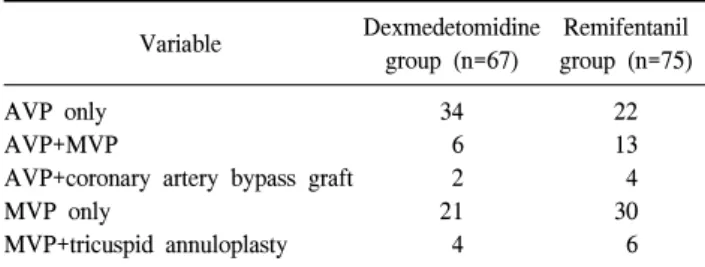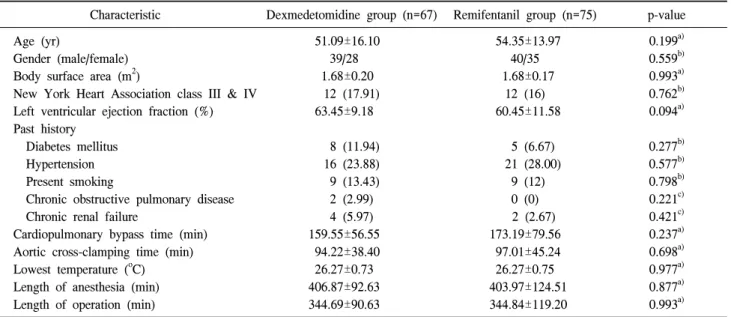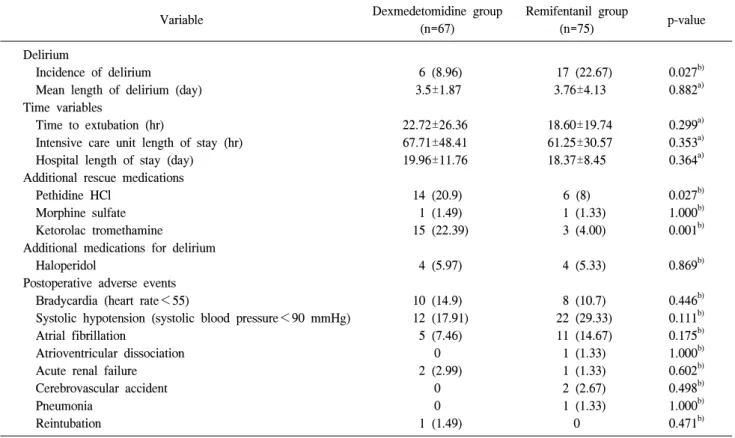http://dx.doi.org/10.5090/kjtcs.2014.47.3.249 ISSN: 2233-601X (Print) ISSN: 2093-6516 (Online)
Department of Thoracic and Cardiovascular Surgery, Konkuk University Medical Center, Konkuk University School of Medicine Received: July 25, 2013, Revised: November 19, 2013, Accepted: November 21, 2013, Published online: June 5, 2014
Corresponding author: Jun Seok Kim, Department of Thoracic and Cardiovascular Surgery, Konkuk University Medical Center, Konkuk University School of Medicine, 120 Neungdong-ro, Gwangjin-gu, Seoul 143-729, Korea
(Tel) 82-2-2030-7593 (Fax) 82-2-2030-5009 (E-mail) drjsk@kuh.ac.kr
C
The Korean Society for Thoracic and Cardiovascular Surgery. 2014. All right reserved.
CC
This is an open access article distributed under the terms of the Creative Commons Attribution Non-Commercial License (http://creative- commons.org/licenses/by-nc/3.0) which permits unrestricted non-commercial use, distribution, and reproduction in any medium, provided the original work is properly cited.
Efficacy and Safety of Dexmedetomidine for Postoperative Delirium in Adult Cardiac Surgery on Cardiopulmonary Bypass
Jae Bum Park, M.D., Seung Ho Bang, M.D., Hyun Keun Chee, M.D., Jun Seok Kim, M.D., Song Am Lee, M.D., Je Kyoun Shin, M.D.
Background: Delirium after cardiac surgery is associated with serious long-term negative outcomes and high costs.
The aim of this study is to evaluate neurobehavioral, hemodynamic, and sedative characteristics of dexmedetomi- dine, compared with the current postoperative sedative protocol (remifentanil) in patients undergoing open heart sur- gery with cardiopulmonary bypass (CPB). Methods: One hundred and forty two eligible patients who underwent cardiac surgery on CPB between April 2012 and March 2013 were randomly divided into two groups. Patients re- ceived either dexmedetomidine (range, 0.2 to 0.8 μg/kg/hr; n=67) or remifentanil (range, 1,000 to 2,500 μg/hr, n=75). The primary end point was the prevalence of delirium estimated daily via the confusion assessment method for intensive care. Results: When the delirium incidence was compared with the dexmedetomidine group (6 of 67 patients, 8.96%) and the remifentanil group (17 of 75 patients, 22.67%) it was found to be significantly less in the dexmedetomidine group (p<0.05). There were no statistically significant differences between two groups in the ex- tubation time, ICU stay, total hospital stay, and other postoperative complications including hemodynamic side effects. Conclusion: This preliminary study suggests that dexmedetomidine as a postoperative sedative agent is as- sociated with significantly lower rates of delirium after cardiac surgery.
Key words: 1. Postoperative care 2. Dexmedetomidine 3. Complication 4. Thoracic surgery
INTRODUCTION
Postoperative delirium is generally known to develop in up to 57% of cardiac-surgery patients [1]. Given this condition’s high incidence rate, the consequences of delirium place a considerable burden on both patients and medical staff be- cause of increased morbidity, higher mortality rates, in- complete functional cognitive recovery, prolonged hospital- ization, and increased costs of long-term treatment [2-4]. A
number of studies have reported that 32% to 84% of delirium
patients go unrecognized by the relevant clinical staff [5], and
the causes of postoperative delirium have not yet been
identified. The known probable risk factors of delirium after
cardiac surgery include advanced age, preexisting cognitive
decline, atrial fibrillation, perioperative medications, previous
delirium, and other metabolic disorders [6]. Among them,
major surgery including cardiac operations may increase the
risk of delirium due to intricacy of the surgical procedure,
administration of perioperative anesthetic and other pharmaco- logical substances, and postoperative complications [7,8]. We hypothesized that the administration of dexmedetomidine (highly selective and potent α-2 adrenergic agonist with seda- tive and analgesic properties) may be associated with a lower incidence of delirium by pharmacological action. It produces sedation with modest analgesic and possible anti-delirium ef- fects with minimal respiratory depression [9,10]. The present study was aimed at the investigation of the postoperative sed- ative effects of dexmedetomidine associated with a lower in- cidence of delirium, compared with the current postoperative sedative protocol (remifentanil) in patients undergoing open heart surgery with cardiopulmonary bypass (CPB). The pri- mary endpoint was the proportion of patients in each group who developed postoperative delirium. Secondary endpoints included intubation time, length of stay in the intensive care unit (ICU), total length of hospitalization, and use of addi- tional rescue medications.
METHODS 1) Study design and patients
All patients undergoing cardiac surgery are prospectively registered in Konkuk University Medical Center. These regis- tries contain baseline characteristics of patients, perioperative evaluation data, and results or other complications of surgery.
All patients fulfilling the inclusion and exclusion criteria and hospitalized for elective open heart surgery were eligible for this study. The study was approved by Konkuk University Medical Center’s independent institutional review board, and informed consent was obtained from each patient. A total of 370 patients underwent cardiac surgery from April 2012 to March 2013. We excluded patients who had re-do and emer- gency surgery, severe pulmonary or systemic disease, left ventricular ejection fraction<40%, pre-existing renal dysfunc- tion (serum creatinine level>2.0 mg/dL), and documented preoperative dementia, Parkinson disease, or recent stroke, and who were older than 90 years or younger than 17 years of age. In addition, patients who had psychotropic medi- cations, evidence of progressed heart block, and surgery re- quiring deep hypothermic circulatory arrest involving thoracic aorta were also excluded. Among them, 142 patients who un-
derwent cardiac surgery on CPB were enrolled in this trial.
These eligible patients were randomly assigned to receive ei- ther dexmedetomidine (n=67) or remifentanil (n=75).
2) Intraoperative procedures
Anesthesia for the operation was initiated according to the standardized protocol in both groups, including induction with propofol, fentanyl, and rocuronium, and maintenance with fentanyl and inhalation agents like sevoflurane. Surgical pro- cedures were approached via either median sternotomy or right thoracotomy in conjunction with CPB. Right thor- acotomy was performed on patients of atrioventricular valve diseases. In thoracotomy, we mostly used the femoral artery and vein or the right internal jugular vein as vascular access for CPB. All patients received standardized CPB management in the same manner. The protocol for CPB included moderate hypothermia (range, 26
oC to 30
oC) and flows initiated at the rate of 60 mL/kg/min, and was adjusted according to the state of hemodilution and core temperature. Patients were weaned from CPB when their rectal temperature reached 35
oC. All patients were monitored with routine cardiac hemo- dynamic monitoring, including transesophageal echocardiog- raphy and pulmonary artery catheter. Bispectral index score (BIS) was also used to estimate the depth of anesthesia by means of an Aspect-3000 BIS monitor. The patients were transferred to, intubated in, and ventilated in cardiovascular ICU (CICU) after surgery.
3) Postoperative administration
Upon return to the CICU, a standardized regimen for post- operative management was followed for all patients; they were started on one of the following two sedative protocols:
dexmedetomidine (loading dose, 0.5 μg/kg; maintenance dose,
0.2 to 0.8 μg/kg/hr) or remifentanil (range, 1,000 to 2,500
μg/hr). Infusion rate of drugs was maintained by titration as
per the specified protocol to maintain target sedation and ad-
equate analgesia by specially trained nurses who were certi-
fied in cardiac intensive care. The efficacy measures for seda-
tion and analgesia were based on the Modified Ramsay
Sedation Scale (1–6) and the Numeric Pain Intensity Scale
(NPIS: 0–10). We intended to maintain a Ramsay sedation
score of 3 (before extubation) and 2 (after extubation).
Table 1. Types of operation
Variable Dexmedetomidine
group (n=67)
Remifentanil group (n=75) AVP only
AVP+MVP
AVP+coronary artery bypass graft MVP only
MVP+tricuspid annuloplasty
34 6 2 21 4
22 13 4 30 6 AVP, aortic valvuloplasty; MVP, mitral valvuloplasty.
Additional analgesic agents (e.g., pethidine, morphine, or ke- torolac) were applied if NPIS exceeded the grade of 7. The patients in both groups were extubated when clinically appro- priate according to respiratory care protocols in CICU. The extubation time as well as the frequency of additional an- algesics given was also documented methodically. If a patient developed delirium, haloperidol (5 mg) every 6 hours was ad- ministered as needed for agitation and not responding to ad- justment of the assigned sedative drugs.
4) Outcome measures
The primary outcome of the study was the proportion of delirium developed during the first 3 days after surgery as determined by the validated delirium instrument, confusion assessment method for ICU (CAM-ICU). The CAM-ICU is the most widely used instrument for diagnosing delirium by medical staff and non-psychiatrists and has been known to have the merits of ease, rapid assessment time, reliability, and validity. CAM-ICU yields a standardized judgment of delir- ium, which was validated against expert views and Diagnostic and Statistical Manual of Mental Disorders, fourth edition, text revision [11]. The study was designed to investigate postoperative delirium in the first 3 days because several oth- er studies have reported that the highest incidence of post- operative delirium occurs during the first 3 postoperative days. CAM-ICU was performed once daily between 10:00 am and 12:00 noon (before midday). Abnormal or delirious be- havior was recorded every turn-over by individually assigned nurses. Meanwhile, CAM-ICU was not performed in patients who had a Ramsay Sedation Score of 4 or higher (comatose state). Secondary outcomes included duration of ventilator support, length of ICU stay, length of hospital stay, and use of additional rescue medications. Additionally, clinical ad- verse events were documented in all patients, which were hy- potension (defined as SBP less than 90 mmHg), bradycardia (defined as heart rate less than 55/min), re-intubation within 48 hours, and renal failure.
5) Statistical analyses
Statistical analyses were performed with PASW SPSS ver.
18.0 (SPSS Inc., Chicago, IL, USA). Categorical variables are expressed as percentages or numbers, and continuous varia-
bles are expressed as means with standard deviations. After testing for normality of distribution, continuous variables were compared using the Student t-test. Categorical variables were compared using the chi-square test or Fisher’s exact test. All p-values less than 0.05 were considered statistically significant.
RESULTS
A majority of the patients underwent single cardiac valve
surgery such as aortic valvuloplasty (AVP) and mitral valvu-
loplasty, and others including various types of combined
valve surgery as well as AVP with coronary artery bypass
grafting (CABG) surgery (Table 1). Patients in both groups
were statistically similar in terms of the preoperative demo-
graphic and baseline characteristics. CPB time, aortic
cross-clamp time, intraoperative lowest temperature, the
length of operation, and total anesthesia time were not sig-
nificantly different between the two groups (Table 2). The
overall incidence of delirium during postoperative first 3 days
was 16% (23 of 142), with 8.96% (6 of 67) occurring in the
dexmedetomidine and 22.67% (17 of 75) in the remifentanil
group, respectively (p<0.05). In postoperative outcomes, no
statistically significant differences were observed between the
two groups in the duration of mechanical ventilator support,
ICU stay, total hospital stay, and other postoperative compli-
cations (p>0.05) (Table 3). However, the number of patients
requiring an additional infusion of analgesics such as pethi-
dine and ketorolac was significantly higher in the dexmedeto-
midine group than in the remifentanil group.
Table 2. Preoperative characteristics and intraoperative details
Characteristic Dexmedetomidine group (n=67) Remifentanil group (n=75) p-value Age (yr)
Gender (male/female) Body surface area (m
2)
New York Heart Association class III & IV Left ventricular ejection fraction (%) Past history
Diabetes mellitus Hypertension Present smoking
Chronic obstructive pulmonary disease Chronic renal failure
Cardiopulmonary bypass time (min) Aortic cross-clamping time (min) Lowest temperature (
oC) Length of anesthesia (min) Length of operation (min)
51.09±16.10 39/28 1.68±0.20
12 (17.91) 63.45±9.18
8 (11.94) 16 (23.88) 9 (13.43) 2 (2.99) 4 (5.97) 159.55±56.55 94.22±38.40 26.27±0.73 406.87±92.63 344.69±90.63
54.35±13.97 40/35 1.68±0.17
12 (16) 60.45±11.58
5 (6.67) 21 (28.00)
9 (12) 0 (0) 2 (2.67) 173.19±79.56 97.01±45.24 26.27±0.75 403.97±124.51 344.84±119.20
0.199
a)0.559
b)0.993
a)0.762
b)0.094
a)0.277
b)0.577
b)0.798
b)0.221
c)0.421
c)0.237
a)0.698
a)0.977
a)0.877
a)0.993
a)Values are presented as mean±standard deviation or number (%).
a)
By Student t-test.
b)
By chi-square test.
c)
By Fisher’s exact test.
DISCUSSION
The present study evaluated the administration of a highly selective α-2 agonist, dexmedetomidine focusing on cardiac postoperative care. The study concluded that sedation with dexmedetomidine was associated with a significantly reduced incidence of postoperative delirium in patients undergoing cardiac surgery with CPB. In general, cardiac surgery, partic- ularly valve surgery, has a high risk of cardiovascular and other complications with a reported incidence of over 30%.
Among others, the occurrence of postoperative cognitive dys- function in patients undergoing cardiac surgery has been at- tributed to the synergistic effect of microemboli, hypo- perfusion, and fast rewarming during CPB [7,8]. However, it is still obscure whether postoperative delirium or cognitive decline is actually related to CPB or not. As for the type of cardiac surgery, it has been known that patients undergoing valvular surgery are at a higher risk of delirium than CABG patients, which makes them potentially more vulnerable to postoperative neuropsychiatric deficits [12]. Similarly, a ma- jority of the patients considered in this study were cardiac valve surgery patients. The low prevalence of delirium in this
study may be justified by the pre-exclusion of certain patients who had diagnosis of dementia or other psychological prob- lems, psychotropic medication, and stroke history.
In addition, choices of sedatives in the postoperative period
may be critical for preventing delirium. The highly sensitive
α-2-adrenergic agonist, dexmedetomidine, has recently at-
tracted considerable attention due to its ability to provide ad-
equate postoperative sedation and analgesia without producing
excessive hypotension or the need for vasopressors, while re-
ducing the risk of delirium after cardiac surgery. Unlike con-
ventional sedatives such as propofol, midazolam, or mor-
phine, dexmedetomidine can produce anxiolysis and sedation
without provoking significant respiratory depression. It seems
that this respiratory advantage of dexmedetomidine is directly
related to postoperative delirium, as other studies have im-
plied that dexmedetomidine’s effects on delirium are not sim-
ply due to its opioid-sparing properties [13]. Several studies
have reported that prolonged periods of intubation increase
the risk of delirium by 1.10 to 7.90 times as compared to
shorter periods of intubation [14]. Consequently, dexmedeto-
midine has another potential advantage in that patients may
be extubated in the sedated state and that they may be main-
Table 3. Postoperative outcome variables and adverse events
Variable Dexmedetomidine group
(n=67)
Remifentanil group
(n=75) p-value
Delirium
Incidence of delirium
Mean length of delirium (day) Time variables
Time to extubation (hr)
Intensive care unit length of stay (hr) Hospital length of stay (day) Additional rescue medications Pethidine HCl
Morphine sulfate Ketorolac tromethamine
Additional medications for delirium Haloperidol
Postoperative adverse events Bradycardia (heart rate<55)
Systolic hypotension (systolic blood pressure<90 mmHg) Atrial fibrillation
Atrioventricular dissociation Acute renal failure Cerebrovascular accident Pneumonia
Reintubation
6 (8.96) 3.5±1.87
22.72±26.36 67.71±48.41 19.96±11.76
14 (20.9) 1 (1.49) 15 (22.39)
4 (5.97)
10 (14.9) 12 (17.91)
5 (7.46) 0 2 (2.99)
0 0 1 (1.49)
17 (22.67) 3.76±4.13
18.60±19.74 61.25±30.57 18.37±8.45
6 (8) 1 (1.33) 3 (4.00)
4 (5.33)
8 (10.7) 22 (29.33) 11 (14.67) 1 (1.33) 1 (1.33) 2 (2.67) 1 (1.33)
0
0.027
b)0.882
a)0.299
a)0.353
a)0.364
a)0.027
b)1.000
b)0.001
b)0.869
b)0.446
b)0.111
b)0.175
b)1.000
b)0.602
b)0.498
b)1.000
b)0.471
b)Values are presented as number (%) or mean±standard deviation.
a)
By Student t-test.
b)


